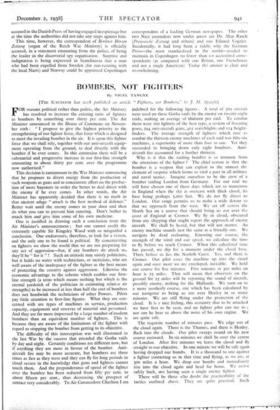SPANISH RAIDERS AND NAZI SPIES
By JOACHIM JOESTEN
WHEN in the first days of November the Franco cruiser ' Nadir ' shelled and sank the Republican freighter Cantabria ' just off the Norfolk coast, few people seemed to realise the full import of this incident. For it was not a casual, nor even an isolated event. Shortly afterwards a Spanish Government ship, pursued by a rebel trawler in the Baltic, was forced to seek refuge in Stockholm, and only a few days later another one fled, in similar circum- stances, into the Norwegian port of Bergen. But still some people were reluctant to see in these incidents an organised extension of the Spanish War to Northern waters.
Those doubts have now been dispelled in a most dramatic manner. Conclusive evidence has come to light that the recent acts of piracy committed in the North Sea and Baltic (as well as some others, now already forgotten, which hap- pened in 1937) are the fruit of a well-organised co-operation between the Insurgent fleet and a secret Nazi intelligence service in Denmark and Sweden.
On November 22nd the Danish police, after careful preparations, unmasked atwa stroke a widespread Nazi spy organisation which had methodically built up, during the last two years, an effective naval and aeronautical intelligence service spanning the whole Baltic and its approaches. It appears from the ample material seized by the police that the activities of the gang had been directed primarily against British shipping. The far-flung and complex apparatus, secretly built up on Danish and Swedish soil, was ready to be set in function immediately a general war broke out.
In the meantime, the Spanish War offered to the plotters an excellent opportunity for exercise. Just as German guns and aeroplanes are now being tried out on Spanish targets, the Nazis' naval intelligence service in North Europe set about practising on Spanish (and Russian) merchantmen trading between North-European ports and Republican Spain. A far-flung network of agents, operating from every Baltic port had been set up to trace; observe and report to the central service in Copenhagen all movements of " suspect " ships, especially through the Big Belt, the Little Belt and The. Sound. Accordingly, a large majority of the persons now under arrest have been apprehended in ports, namely, in Copenhagen, Aarhus, Esbjerg, The Skaw, Nyborg, Korsor, Elsinore and Ronne (on the isle of Bornholm). The Swedish authorities, on their side, have disclosed that the gang had relays in Stockholm, Malmo, Gothenburg and Halsingborg.
Many interesting details of the gang's activities have already been divulged, others are probably still being withheld from a wider public. It operated with several secret broadcasting stations and a complex code system (one of the spies, Voigt, was caught on his way to Copenhagen where he was to exchange his cipher code for a new one). It proceeded to methodical research into nautical and hydrographical condi- tions, measuring the coastline, fathoming the waters and so forth. A large collection of maps, charts and drawings specially made for this purpose fell into the hands of the police. Before all, the gang had worked out a complete sig- naling service and this was, incidentally, what led to their unmasking. For the first suspicions were aroused when casual passers-by observed mysterious light-signals between the villa of the above-named Voigt (which lies conveniently on the waterfront at Korsor) and vessels in the Big Belt.
But the most sensational aspect of the whole affair is provided by the personalities of the gang-leaders. Out of a total of 14 arrested up to this day, no fewer than to are Reich citizens, the rest being Danes. And among the Germans, there are three newspaper correspondents, all duly accredited and members of the Foreign Press Associa- tion in Copenhagen. It had long been rumoured that the Nazi correspondents in Scandinavia were not real journalists, but mostly spies and agitators under disguise. But not before now has official proof of this suspicion been provided. In March, 1936, it is true, VtYlkischer Beobachter's corre- spondent in Copenhagen, Herr Ernst Schafer. was widely accused in the Danish Press of having engaged in espionage but at the time the authorities did not take any steps against him.
This time, however, the correspondent of Berliner Biirsen Zeitung (organ of the Reich War Ministry) is officially accused, in a statement emanating from the police, of being the leader in the discovered spy organisation. Surprise and indignation is being expressed in Scandinavia that a man who had been expelled from Sweden (for run-running with the local Nazis) and Norway could be appointed Copenhagen correspondent of a leading German newspaper. The other two Nazi journalists now under arrest are Dr. Max Rasch (Preussische Zeitung and others) and one Eduard Vogeler. Incidentally, it had long been a riddle why the German Press—the most standardised in the world—needed to maintain in Copenhagen no fewer than ten accredited corre- spondents (as compared with one Briton, one Frenchman and not a single American). Today the answer is clear and overwhelming.



























































 Previous page
Previous page